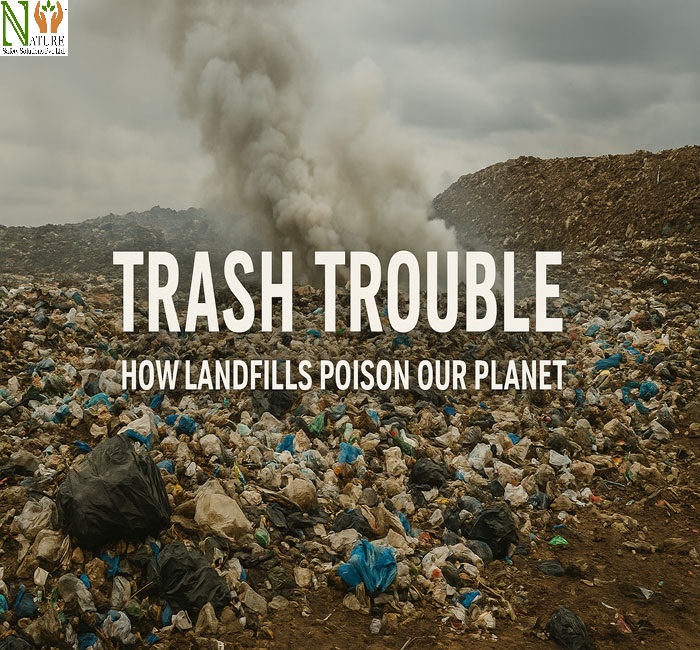Every day, millions of tons of waste are thrown away across the world. Much of this garbage ends up in landfills, large areas of land where waste is buried. At first glance, landfills may seem like a convenient solution to get rid of trash. However, behind this solution hides a serious problem. Landfills are not just places where garbage disappears; they are ticking time bombs for our environment, health, and future.

What Are Landfills?
Landfills are large pits or sites where waste is collected, compacted, and buried under layers of soil. They are designed to store garbage safely. In theory, landfills isolate waste from the environment to prevent harm. But in reality, they often fail to do so. Over time, waste breaks down, releases toxic liquids and gases, and causes pollution.
The Hidden Dangers of Landfills
1. Soil and Water Pollution
When garbage decomposes in landfills, it produces a liquid called leachate. This toxic liquid seeps into the ground and contaminates soil and underground water. If not controlled, leachate can pollute rivers, lakes, and drinking water sources. Once water is polluted, it is almost impossible to make it clean again. Communities living near landfills often face higher risks of waterborne diseases.
2. Air Pollution and Greenhouse Gases
Landfills release large amounts of methane gas as waste breaks down. Methane is a powerful greenhouse gas, more dangerous than carbon dioxide in trapping heat in the atmosphere.
This means landfills directly contribute to climate change. They also release foul odors and harmful gases like hydrogen sulfide, which can cause breathing problems, headaches, and nausea for nearby residents.
3. Health Hazards for People
Living near landfills is dangerous. Studies have shown higher rates of asthma, respiratory issues, and even certain cancers among people who live close to landfill sites. Children are especially at risk because their immune systems are still developing. In addition, landfills attract pests like rats, flies, and mosquitoes, which spread diseases.
4. Loss of Land and Natural Beauty
Landfills take up huge amounts of land that could have been used for housing, farming, or green spaces. Once an area becomes a landfill, it is almost impossible to use it again for safe purposes. What’s worse, these giant garbage mountains spoil the natural beauty of landscapes and often lower property values nearby.
5. Long-Term Environmental Damage
Garbage buried today does not simply disappear. Plastic, electronic waste, and other non-biodegradable materials can remain in landfills for hundreds of years. This means future generations will inherit not only our waste but also the problems it creates.
Why Do We Still Depend on Landfills?
If landfills are so harmful, why do we keep using them? The answer lies in convenience and cost. Landfilling is the cheapest and easiest way to manage waste, especially for growing cities.
Recycling systems, composting, and waste-to-energy plants require planning, investment, and cooperation. Many countries lack proper waste management infrastructure, which makes landfills the default option.
The Way Forward: Reducing Landfill Dependence
Waste Reduction at the Source
The best way to fight landfill problems is to create less waste. Choosing reusable items instead of single-use plastics, avoiding unnecessary packaging, and buying only what we need are simple steps that reduce the trash we generate every day.
Recycling and Reuse
Much of the waste in landfills can be recycled. Materials like paper, glass, plastic, and metals can be collected, processed, and reused. Recycling reduces the need for raw materials and saves energy. However, recycling works only when people separate their waste properly and when governments provide efficient collection systems.
Composting Organic Waste
Food scraps and garden waste make up a large part of landfill garbage. Instead of sending them to landfills, households and communities can compost them. Composting turns organic waste into nutrient-rich soil, which can be used for gardening and farming.
Waste-to-Energy Solutions
Modern technology allows us to convert waste into energy. Waste-to-energy plants burn or process garbage to produce electricity and heat. While this method still has environmental impacts, it is far cleaner than dumping waste in landfills.
Strict Policies and Public Awareness
Governments need to create strict rules to limit landfill use and encourage recycling. At the same time, people must be educated about the dangers of landfills and the importance of waste reduction. Without awareness, even the best policies will fail.
Also read:-
